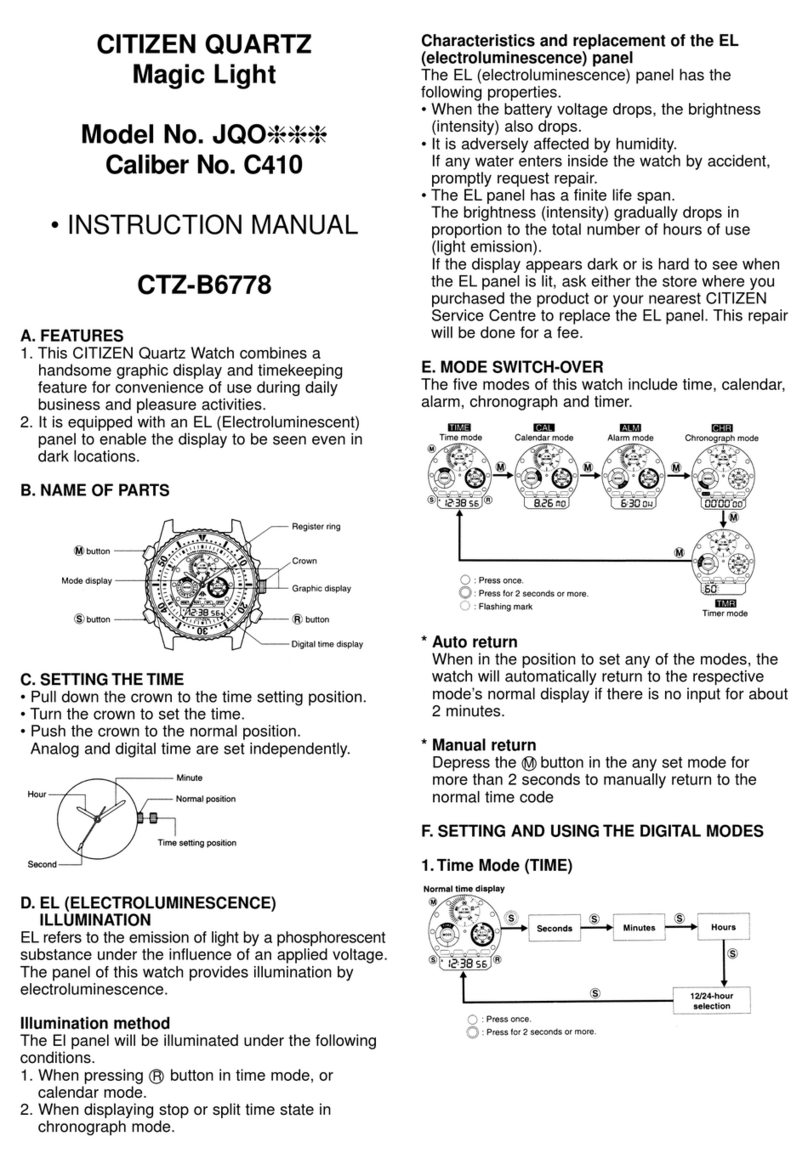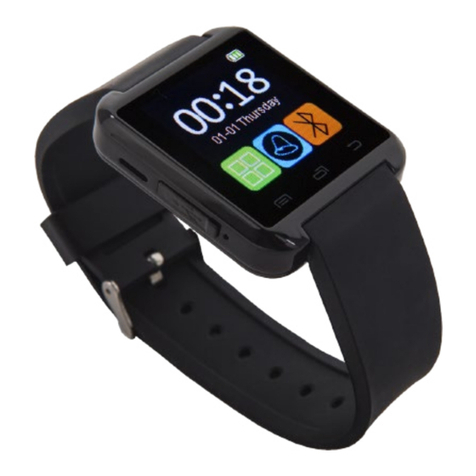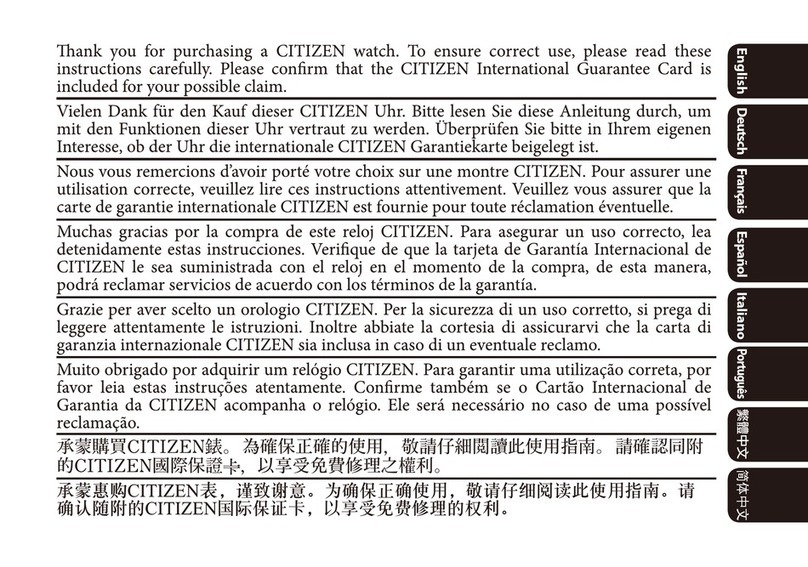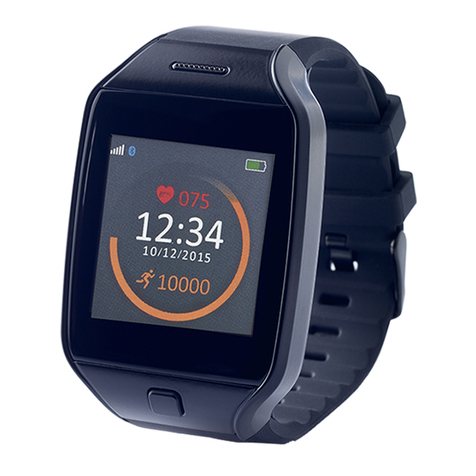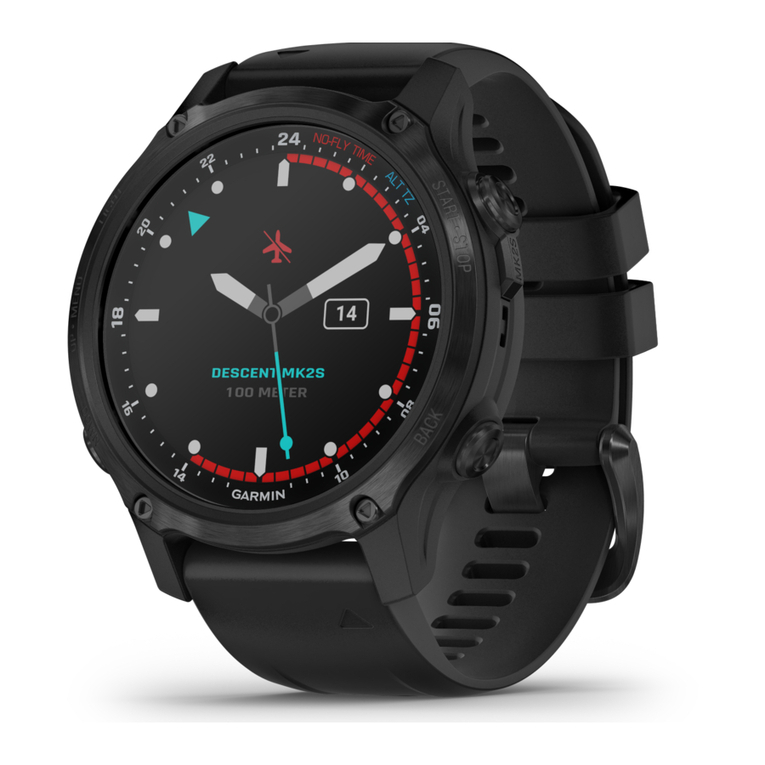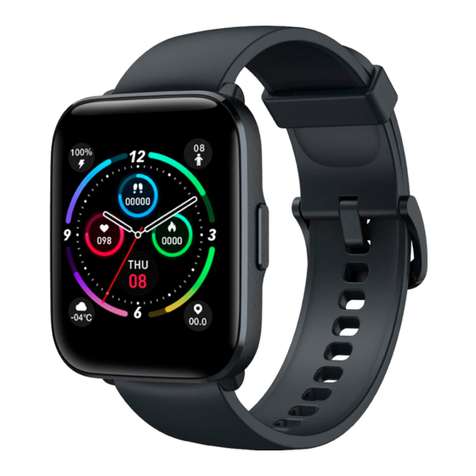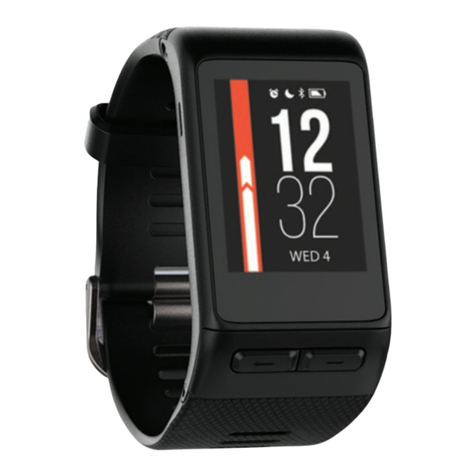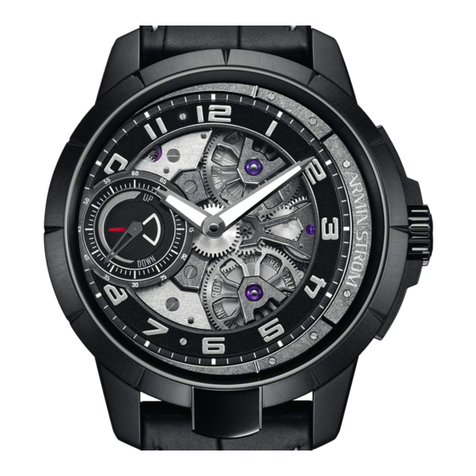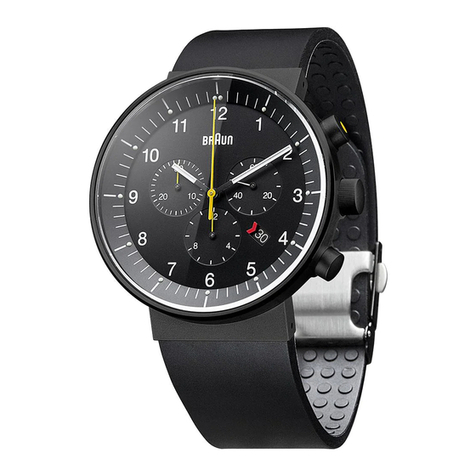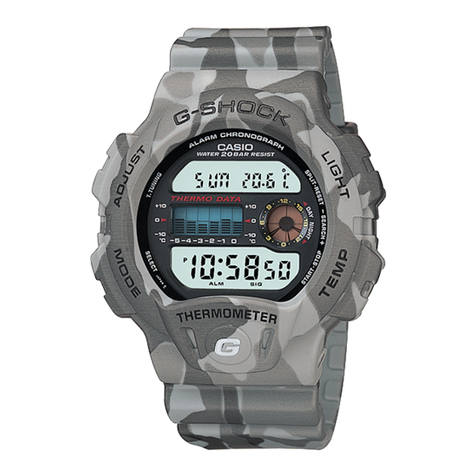Insetto ISSEY MIYAKE User manual

English-17
E
CONTENTS
HOW TO USE ..............................................................................18
TO PRESERVE THE QUALITY OF YOUR WATCH ....................22
TROUBLE SHOOTING ................................................................25
REMARKS ON AFTER-SALES SERVICING AND GURANTEE ......
26
REMARKS ON THE REPLACEMENT PARTS ............................26
SPECIFICATIONS .......................................................................27
ACCURACY OF MECHANICAL WATCHES ................................28
For the care of your watch, see the Guarantee and Instruction
Booklet.

English-18
Minute hand
Calendar
abc
Crown
Second hand
Hour hand
a: Normal position
b: First click
c: Second click
HOW TO USE
●PART NAMES AND FUNCTIONS

English-19
E
●HOW TO USE THEAUTOMATIC MECHANICAL WATCH
•This is an automatic mechanical watch with manual winding
mechanism.
• If the watch is worn on the wrist, the mainspring will be wound
automatically through normal wrist movement. It can be wound by
turning the crown.
• To start the watch after it stops completely, wind it up either by
turning the crown or swinging it from side to side until the second
hand starts moving. Then set the time before wearing the watch on
the wrist.
• To wind up the watch, turn the crown clockwise slowly. The watch
cannot be wound by turning the crown counterclockwise.
• Once wound up fully, it operates for about 50 hours.
* If the watch is used without being wound
up fully, gain or loss of the watch may
result. To avoid this, wear the watch for
more than 8 hours a day. If the watch is
used without wearing on the wrist; if it is
use on the desk, for example: be sure to
wind it up fully every day at a fixed time.

English-20
●TIME / DATE SETTING
• After the watch starts operating, set the time and date.
• This watch has a date display function. The date is incremented
by 1 day every 24 hours.
1. Pull out the crown to the first click.
The second hand will continue
moving.
* Do not change the date between 8:00 P.M.
and 2:00 A.M.. If you change the date at
that time, it does not work correctly.
2.Turn the crown clockwise to set
the date to the previous day’s
date.
3. When the second hand points to
the 12 o'clock mark, pull out the
crown to the second click. (The
second hand will then stop.)
Move the hour hand by turning the
crown counterclockwise, and set
the date and time.

English-21
E
* The mechanism of the mechanical watch is different from that of the quartz one. To
set the time accurately, first turn the minute hand 4 to 5 minutes behind of the desired
time and then advance it to the correct time.
* The watch is so designed that date changes once by turning the hour hand 24 hours.
* The date changes between 10:00 P.M. and 0:00 A.M.. When setting the time, therefore,
check that AM/PM is set properly.
4.Push the crown back in to the
normal position in accordance
with a time signal.
●DATE ADJUSTMENT AT THE END OF THE MONTH
It is necessary to adjust the date at the end of February and 30-day
months.
[To adjust the date in the A.M. period on the first day of the month
following a 30-day month]
1. The watch displays “31” instead of “1”. Pull out the crown to the
first click.
2. Turn the crown to set the date to “1” and then push the crown back
in to the normal position.

English-22
TO PRESERVE THE QUALITY OF YOUR WATCH
●CARE OF YOUR WATCH
• The case and bracelet touch the skin directly just as underwear. If they are left dirty,
the edge of a sleeve may be stained with rust of those who have a delicate skin may
have a rash.
• After removing the watch from your wrist, wipe perspiration or moisture with a soft
cloth. This will prevent the watch from being soiled, adding to the life of the gasket.
<LEATHER BAND>
• When removing moisture from a leather band, do not rub the band with the cloth as
this may discolor it or reduce its gloss. Be sure to blot up the moisture using a soft dry
cloth.
<METAL BRACELET>
• Clean the watch bracelet with a soft toothbrush dipped in water or soapy water. If
your watch is not water-resistant, be careful not to get the case wet when cleaning.
●RASH AND ALLERGY
• Adjust the bracelet or band so that there will be a little clearance between the bracelet
or band and your wrist to avoid accumulation of perspiration.
• If you are constitutionally predisposed to rash, the band may cause you to develop a
rash or an itch depending on your physical condition.
• The possible causes of the rash are as follows:
1. Allergy to metals or leathers
2. Rust, dust or perspiration on the watch or band
• If you develop any skin reactions, take off the watch and consult a doctor immediately.
CAUTION
CAUTION

English-23
E
●PRECAUTIONS ON WEARING YOUR WATCH
• In case you tumble and fall or bump into others with the watch worn on your wrist, you
may be injured by the reason of the fact that you wear the watch.
• When you make contact with children, especially with infants, they may get injured or
develop a rush caused by allergy.
• Be careful not to drop or hit the watch against hard objects. Do not wear the watch
when you play active sports. It may stop or move incorrectly.
●PLACES TO KEEP YOUR WATCH
• If the watch is left in a temperature below -10 °C or above +60°C for a long time, its
performance may be impaired or it may stop operating.
• Do not leave the watch in a place where it is subjected to strong magnetism.
• Do not leave the watch where there is strong vibration.
• Do not leave the watch in a dusty place.
• Do not expose the watch to gases or chemicals.
(Ex.: Organic solvents such as benzine and thinner, gasoline, nail polish, cosmetic
spray, detergent, adhesives, mercury, and iodine antiseptic solution.)
• Do not leave the watch in a hot spring, or do not keep it in a drawer having insecticides
inside.

English-24
●WATER RESISTANCE
•The watch is 3 bar water resistant, and is designed to withstand accidental
contact with water, such as splashes and rain. Do not use it in water.
• Do not turn or pull out the crown when the watch is wet, as water may get inside the
watch.
●PERIODIC CHECK
• We suggest that you have your watch checked by the retailer from whom the watch
was purchased every 2 or 3 years. Depending on how the watch is used, the lubrication
of the watch mechanism may become insufficient, parts may become worn due to
impurities in the lubricating oil, or the watch may be running noticeably fast or late.
Seals, etc., may also become worn and the watch may stop being waterproof. Take
your watch to the retailer from whom you purchased it for inspection and adjustment
through disassembly/cleaning.
• When the replacing the parts, please specify “GENUINE PARTS”.
• Be sure to have the gasket and push-pin replaced with new ones by the retailer from
whom the watch was purchased when checking the watch.
CAUTION

English-25
E
TROUBLE SHOOTING
Phenomenon
• The watch stops
operating.
• The watch gains
or loses time
temporarily.
• Thedate numeral
changes in the
day time.
• The surface of
theglass is foggy.
Possible cause
• The mainspring is not wound.
• It was left in extremely high or low
temperature.
• The watch was brought into close
contact with a magnetic object.
• You dropped the watch, hit it against a
hard surface or wore it while playing
active sports.
• The watch was subjected to strong
vibration.
• The watch was not taken in for
inspection and adjustment through
disassembly/cleaning for a long time
exceeding 3 years.
• The time is shifted 12 hours.
• Water entered the watch through a
deteriorated packing.
Solution
• Winding up the mainspring or
swinging the watch from side to
side will get it moving again. If this
fails, contact the retailer from
whom the watch was purchased.
• This condition will be corrected
when the watch temperature
returns to normal.
• This condition will be corrected
when the watch is kept away from
close contact with the magnetic
source. If the condition is not
corrected, contact the retailer from
whom the watch was purchased.
• The accuracy cannot be restored
to its original level. Contact the
retailer from whom the watch was
purchased.
• Contact the retailer from whom the
watch was purchased.
• Ad¢ce the hour hand 12 hours.
• Contact the retailer from whom the
watch was purchased.
* If any other symptoms appear, contact the retailer from whom the watch was purchased.

English-26
REMARKS ON AFTER-SALES SERVICINGAND GURANTEE
• If the watch requires service, take it to the retailer from whom the
watch was purchased. If the trouble occurs within the guarantee
period, submit the certificate of guarantee together with the watch.
• For repair after the guarantee period or for any other information
regarding the watch, contact the retailer from whom the watch was
purchased. If there are any unclear points, contact the location
listed on the guarantee.
• Guarantee coverage is spelled out in the certificate of guarantee.
Please read it carefully and keep the certificate for ready reference.
REMARKS ON THE REPLACEMENT PARTS
(Replacement parts are those which are essential to maintaining the
functional integrity of the watch.)
• The number of years that a watch is considered repairable may
vary greatly depending on the conditions under which it was used,
and normal accuracy may not be achieved in some cases. We
recommend, therefore, that you consult the retailer from whom the
watch was purchased when having the repair your watch.
• The case, dial, hands glass and band, or parts thereof may be
replaced with substitutes if the originals are not available.

English-27
E
SPECIFICATIONS
1.Time indication ................Three hands
Time display function
(hour, minute, second)
Date
2.Vibrations per hour..........28,800
3.Mobile accuracy*.............Day rate +15 seconds to -10 seconds
Loss/gain in normal temperatures of
between 5 ºC and 35 ºC
4.Driving system ................Wind-up spring (Self-winding type with
manual winding type)
5.Jewels .............................26 jewels
* Due to the mechanism of mechanical watches, actual loss/gain may not fall within the
range of time accuracy specified above, depending on the conditions of use, such as
the length of time during which the watch is worn on the wrist, life style (whether
much arm movement is involved or not), the degree to which the mainspring is wound
up, etc.
* The above specifications are subject to change without notice.

English-28
ACCURACY OF MECHANICAL WATCHES
(1) Mobile accuracy and static accuracy
• “Mechanical watch accuracy” has two meanings. In this document,
“mobile accuracy” refers to accuracy expressing weekly time gain/
loss in a watch worn under given conditions as a daily average.
• On the other hand, mechanical watch inspections generally
measure time gain/loss in a static state in which movements are
subjected to a number of orientation and temperature conditions.
This is called “static accuracy.”
(2) Daily rate
The accuracy of mechanical watches is called the “daily rate.”
The accuracy of mechanical watches varies slightly from day to day
and usually is not fixed. Thus, the gain/loss of a watch that is worn is
not judged on a single-day basis and instead a weekly average is
used. Depending on the number of hours the watch is used, the usage
environment, etc., the accuracy range indicated In this document may
be exceeded.

English-29
E
(3) Accuracy variation due to temperature
Metal is used in the parts that contribute to the accuracy of mechanical
watches. A well-known characteristic of metals is their tendency to
expand and contract as the result of changes in temperature. This in
turn affects the accuracy of a watch. Mechanical watches tend to run
slow at high temperatures, and run fast at low temperatures.
(4) Mainspring tension and accuracy
Supplying a regular amount of energy to the balance wheel that
controls the speed of the wheels is an important aspect of raising the
accuracy.
The mainspring, which is the power source of the mechanical clock,
has a different amount of force depending on whether it is tightly
wound or on the verge of becoming totally unwound. The less it is
wound, the weaker its force.
A relatively stable accuracy can be obtained by fully winding the
mainspring at a fixed time every day.

English-30
Table of contents
